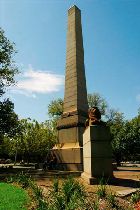Multimedia Content

South African War Memorial (aka Memorial to Fallen Soldiers, and Monument to the 5th Victorian Contingent), 1904 - , by Architect G. De Lacy-Evans; sculptor Joseph Hamilton, courtesy of City of Melbourne.
Details
South African War Memorial (aka Memorial To Fallen Soldiers, and Monument To The 5th Victorian Contingent)
Architect G. De Lacy-Evans; sculptor Joseph Hamilton
Sandstone and bluestone sculpture
1904
Kings Domain, corner of St Kilda Road and Government House Drive
The Boer War, or South African War, was fought from 1899 to 1902, the British pitted against the Boers (now called Afrikaners). Many opposed Britain's policy, and in Australia many questioned why the nation should be involved. Nevertheless, loyalty to Empire ruled and 16 000 troops were sent, almost a quarter from Victoria. The 5th Victorian Contingent was the largest of eight sent by the state. Some 228 Victorians were killed during the war, which ended with the signing of the Treaty of Vereeniging in May 1902.
Following the return of soldiers, the remaining members of the 5th Victorian Contingent erected this monument to honour their fallen comrades. It is a secular memorial, with traditional funerary symbolism on an elaborate and Gothic scale. Four bronze plaques commemorate the soldiers and in part the text reads: 'Unveiled by members of the 5th Victorian Contingent VMR/ in memory of their fallen comrades in South Africa 1901-1902/ Honour the brave/ King and Empire/ Lest we forget/ AD 1903'. One face of the monument is oriented due west, as is common with memorials to lost soldiers.
The monument was originally constructed opposite the Victoria Barracks, on St Kilda Road, but was relocated in 1965. In 1911, it was decided that a memorial would be erected to all Australians who perished during the war; the Boer War Memorial is located nearby and now administered by the City of Port Phillip.
